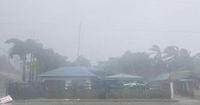Typhoon Matmo, the 21st named storm of the 2025 Pacific typhoon season, struck southern China with unrelenting force over the weekend, prompting one of the largest evacuations in recent memory and testing the region’s disaster response capabilities. As the storm barreled toward the coast, authorities in Guangdong and Hainan provinces scrambled to relocate hundreds of thousands of residents, tourists, and workers to safety, while bracing for the typhoon’s powerful winds and torrential rains.
According to Xinhua and China’s National Meteorological Center, Typhoon Matmo made landfall along the eastern coast of Xuwen county, Zhanjiang city in Guangdong Province around 2:50 pm on Sunday, October 5, 2025. The typhoon’s maximum sustained wind speed at the center reached a staggering 151 kilometers per hour (94 mph)—or 42 to 45 meters per second—accompanied by a central minimum pressure of 965 hectopascals. Meteorologists warned that the storm, though expected to weaken as it moved inland, would bring heavy rains and strong gusts to a broad swath of southern China.
The response was swift and massive. As reported by The Paper and the Associated Press, the government evacuated approximately 347,000 people from the southern provinces of Guangdong and Hainan in anticipation of the typhoon’s arrival. In Guangdong alone, 151,352 residents were moved from potentially dangerous areas. Meanwhile, the island province of Hainan relocated over 197,000 people from high-risk zones by noon on Sunday, with a red-level typhoon warning—the highest in China’s system—remaining in effect throughout the weekend.
In the city of Zhanjiang, which bore the brunt of Matmo’s landfall, schools, industrial activities, and highways were shuttered from the evening of October 4. Local media aired dramatic footage of large waves crashing onto coastal roads in Zhanjiang’s villages, as seawater surged inland. Authorities in Hainan preemptively canceled flights, suspended public transport, and closed businesses starting Saturday, determined to minimize the risk to life and property.
Tourists, too, found themselves swept up in the region-wide evacuation effort. According to Xinhua News Agency, approximately 26,000 tourists on Weizhou Island in the Guangxi Zhuang Autonomous Region were safely evacuated, with no one left stranded. All coastal passenger ferry routes in Guangxi were suspended, and the region’s maritime authority activated its top-level emergency response on Sunday morning. In a coordinated operation, 168 vessels were directed to safe waters and 889 ships were secured in port, while 4,024 personnel from ships and oil platforms were relocated to safety.
Coastal projects and ports across the region halted operations as the typhoon intensified. Emergency teams were deployed to restore power and communication in the affected areas, a crucial step as Matmo’s winds battered infrastructure and threatened to leave communities isolated. According to meteorological authorities, the typhoon was moving west-northwest and was expected to enter the Beibu Gulf by evening, continuing its path toward northern Vietnam and China’s Yunnan province.
Rainfall was another major concern. Authorities warned of heavy downpours, forecasting between 100 to 249 millimeters (3.93 to 9.8 inches) of rain in parts of Guangdong and Hainan. Such volumes raised the risk of flash floods and landslides, particularly in mountainous and agricultural regions. In Macau, although not directly in the typhoon’s path, classes and tutoring sessions were canceled due to deteriorating weather conditions.
Typhoon Matmo’s impact was not limited to China. Earlier in the week, the storm swept through the Philippines, affecting more than 220,000 people across five northern agricultural plains and mountainous regions. Nearly 35,000 residents there moved to emergency shelters or the homes of relatives to escape landslide- and flood-prone areas, according to disaster-response officials cited by The Paper. Fortunately, there were no immediate reports of casualties or major damage in the Philippines.
Back in China, the scale of the evacuation and emergency response was striking. The cumulative evacuations in Guangdong and Hainan alone exceeded 347,000 people—a testament to both the severity of Matmo and the authorities’ determination to avoid tragedy. China’s National Meteorological Center’s issuance of a red-level typhoon warning underscored the seriousness of the situation.
"The typhoon has strengthened to severe with winds up to 45 meters per second," noted meteorological authorities, as cited by Xinhua. Emergency teams worked tirelessly to restore power and communication, crucial for both the safety of those evacuated and the coordination of ongoing relief efforts.
While the storm’s intensity began to diminish after landfall, meteorologists cautioned that the risks were far from over. Heavy rains and strong gusts were forecast for southern regions, and the threat of flooding remained high. The storm was expected to continue moving westward and north, bringing its rains to northern Vietnam and Yunnan province in China.
For many in the region, the storm’s approach was a test of both personal resilience and the effectiveness of China’s disaster preparedness systems. The rapid suspension of flights and public transport, the closure of schools and businesses, and the mass evacuation of residents and tourists all point to a country determined to learn from past disasters and minimize the loss of life.
In the end, Typhoon Matmo’s passage through southern China will be remembered as much for the scale of the evacuation and coordinated response as for the storm’s raw power. The images of deserted streets, shuttered ports, and families sheltering far from home serve as a reminder of nature’s unpredictability—and the importance of readiness in the face of such threats.
As the region begins to recover and emergency teams work to restore normalcy, the lessons learned from Matmo’s onslaught will no doubt inform future responses. For now, the focus remains on ensuring the safety of those displaced and rebuilding what the typhoon left behind.


